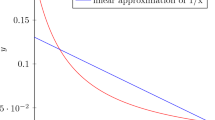Abstract
Modular multiplication can be performed in the residue number system (RNS) using a type of Montgomery reduction. This paper presents an alternative in which RNS modular multiplication are performed by using the core function. All of the intermediate calculations use short wordlength operations within the RNS. This work contributes to the long wordlength modular multiplication operation \(Z = A \times B \mod M\), the basis of many DSPs and public-key cryptosystems.


Similar content being viewed by others
References
Akushskii, J., Burcev, V.M., Pak, I.T.: A new positional characteristic of nonpositional codes and its applications. In: Amerbsev, V.M. (ed.) Coding theory and the optimization of complex systems. SSR, Alm-Ata ‘Nauka’ Kazah (1977)
Bajard, J.C., Didier, L.S., Kornerup, P.: Modular multiplication and base extensions in residue number systems. In: Proceedings of 15th IEEE Symposium on Computer Arithmetic, vol. 2, pp. 59–65 (2001)
Barraclough, S.R.: The design and implementation of the ims a110 image and signal processor. In: Proceedings of IEEE CICC, pp. 24.5/1–4, San Diego (1989)
Baugh, C., Wooley, B.: A two’s complement parallel array multiplication algorithm. IEEE Trans. Comput. 22(12), 1045–1047 (1973)
Philips, Braden, Kong, Yinan, Lim, Z.: Highly parallel modular multiplication in the residue number system using sum of residues reduction. Appl. Algebra Eng. Commun. Comput. 21, 249–255 (2010)
Burgess, N.: Scaled and unscaled residue number system to binary conversion techniques using the core function. In: Proceedings of 13th IEEE Symposium on Computer Arithmetic, pp. 250–257 (1997)
Burgess, N.: Scaling an RNS number using the core function. In: Proceedings of 16th IEEE Symposium on Computer Arithmetic (2003)
Chokshi, R., Berezowski, K.S., Shrivastava, A., Piestrak, S.J.: Exploiting residue number system for power-efficient digital signal processing in embedded processors. In: Proceedings of the 2009 international conference on Compilers, architecture, and synthesis for embedded systems (CASES09), pp. 19–27 (2009)
Dadda, L.: Some schemes for parallel multipliers. Alta Freq. 34, 349–356 (1965)
Dhanesha, H., Falakshahi, K., Horowitz, M.: Array-of-arrays architecture for parallel floating point multiplication. In: Proceedings of Conference on Advanced Research in VLSI, pp. 150–157 (1995)
Elleithy, K., Bayoumi, M.: A massively parallel RNS architecture. In: 25th Asilomar Conference, 1991, Conference Record of the Asilomar Conference on Signals, Systems and Computers, vol. 2, pp. 408–412 vol. 1. Institute of Electrical and Electronics Engineers Computer Society, Pacific Grove, CA (1991). doi:10.1109/ACSSC.1991.186482
Gonnella, J.: The application of core functions to residue number systems. IEEE Trans. Signal Process. 39, 284–288 (1991)
Hatamian, M., Cash, G.: A 70-mhz 8-bit \(\times \) 8-bit parallel pipelined multiplier in 2.5-\(\mu \)m cmos. JSSC 21(4), 505–513 (1986)
Hennessy, J., Patterson, D.: Computer Architecture: A Quantitative Approach. Morgan Kaufmann, San Mateo (1990)
Itoh, N., et al.: A 600-mhz 54 \(\times \) 54-bit multiplier with rectangular-styled wallace tree. IEEE J Solid-State Circuits 36(2), 249–257 (2001)
Jenkins, W.K.: Finite Arithmetic Concepts. In: Mitra, S.K., Kaiser, J.F. (eds.) Handbook for Digital Signal Processing, pp. 611–675. Wiley, London (1993)
Kong, Y., Lai, Y.: Low latency modular multiplication for public-key cryptosystems using a scalable array of parallel processing elements. In: 2013 IEEE 56th International Midwest Symposium on Circuits and Systems (MWSCAS), pp. 1039–1042 (2013). doi:10.1109/MWSCAS.2013.6674830
Kong, Y., Phillips, B.: Residue number system scaling schemes. In: Al-Sarawi, S.F. (ed.) Proceedings of SPIE, Smart Structures, Devices, and Systems II, vol. 5649, pp. 525–536 (2005)
Miller, D.D., Polky, J.N., King, J.R.: A survey of soviet developments in residue number theory applied to digital filtering. In: Proceedings of the 26th Midwest Symposium on Circuits and Systems (1983)
Mohan, A.: Residue Number Systems: Algorithms and Architectures. Kluwer Academic Pub, Dordrecht (2002)
Mou, Z., Jutand, F.: A class of close-to-optimum adder trees allowing regular and compact layout. In: Proceedings of IEEE International Conference on Computer Design, pp. 251–254 (1990)
Ohkubo, N., et al.: A 4.4 ns cmos 54 \(\times \) 54-bit multiplier using pass-transistor multiplexer. IEEE J Solid-State Circuits 30(3), 251–257 (1995)
Omondi, A., Premkumar, B.: Residue Number Systems—Theory and Implementation, Advances in Computer Science and Engineering: Texts, vol. 2. Imperial College Press, UK (2007)
Orup, H., Kornerup, P.: A high-radix hardware algorithm for calculating the exponential \(m^e\). In: Proceedings of the 10th IEEE Symposium on Computer Arithmetic, vol. 576, pp. 51–57 (1991)
Paliouras, V., Stouraitis, T.: Multifunction architectures for rns processors. IEEE Trans. Circuits Syst. II Analog Digit. Signal Process. 46(8), 1041–1054 (1999)
Parhami, B.: Computer Arithmetic—Algorithms and Hardware Designs. Oxford University Press, Oxford (2000)
Ramirez, J., Garcia, A., Lopez-Buedo, S., Lloris, A.: Rns-enabled digital signal processor design. Electron. Lett. 38(6), 266–268 (2002)
Richman, F.: Number theory: an introduction to algebra. Contemporary undergraduate mathematics series, Brooks/Cole Publ. Co. (1971)
Santoro, M.: Design and clocking of vlsi multipliers. Ph.d. thesis, Stanford University, CSL-TR-89-397 (1989)
Soderstrand, M.A., Jenkins, W., Jullien, G.: Residue Number System Arithmetic: Modern Applications. IEEE Press, New Jersey (1986)
Sutherland, I.S., Sproull, B., Harris, D.: Logical Effort: Designing Fast CMOS Circuits. Morgan Kaufmann, San Francisco (1999)
Szabo, N.S., Tanaka, R.H.: Residue Arithmetic and its Applications to Computer Technology. McGraw Hill, New York (1967)
Wallace, C.: A suggestion for a fast multiplier. IEEE Trans. Electron. Comput. EC–13, 14–17 (1964)
Walter, C.D.: Faster multiplication by operand scaling. In: Advances in Cryptology - Crypto 91. Lecture Notes in Computer Science, vol. 576, pp. 313–323. Springer, Berlin/Heidelberg, Germany (1992)
Weinberger, A.: 4—2 carry-save adder module. IBM Techn. Discl. Bull. 23, 3811–3814 (1981)
Weinberger, A., Smith, J.: A logic for high-speed addition. In: System Design of Digital Computer at the National Bureau of Standards: Methods for High-Speed Addition and Multiplication, Circular 591, vol. 23, chap. 1, pp. 3–12. National Bureau of Standards (1958)
Weste, N., Harris, D.: CMOS VLSI Design—A Circuit and Systems Perspecitive, 3rd edn. Addison Wesley, Boston (2004)
Zuras, D., McAllister, W.: Blalanced delay trees and combinatorial division in vlsi. IEEE J Solid-State Circuits 21(5), 814–819 (1986)
Author information
Authors and Affiliations
Corresponding author
Rights and permissions
About this article
Cite this article
Kong, Y., Asif, S. & Khan, M.A.U. Modular multiplication using the core function in the residue number system. AAECC 27, 1–16 (2016). https://doi.org/10.1007/s00200-015-0268-1
Received:
Revised:
Accepted:
Published:
Issue Date:
DOI: https://doi.org/10.1007/s00200-015-0268-1




